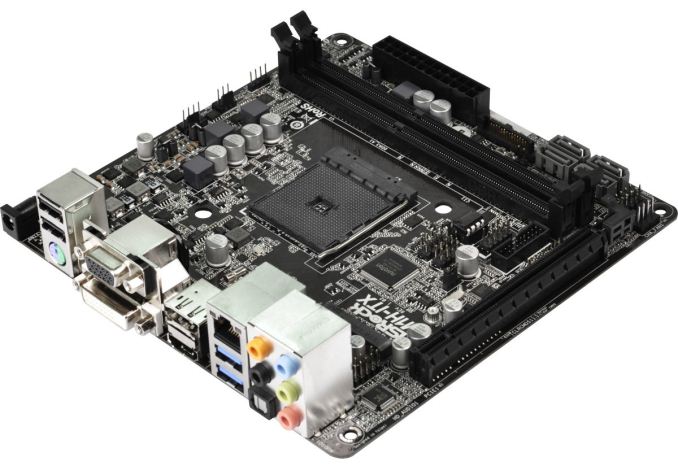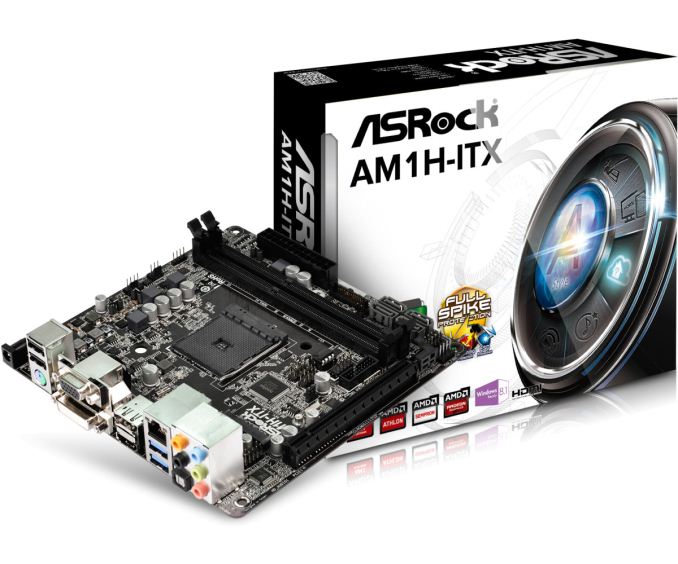The AM1 Kabini Motherboard Preview: Analyzing the Hardware
by Ian Cutress on April 19, 2014 2:00 PM ESTASRock AM1H-ITX
The last motherboard in our roundup is one we have previously featured on AnandTech before Kabini launch. The ASRock AM1H-ITX takes a different direction almost entirely by providing users with the option of powering the system by a power supply or a standard 19V laptop charger. For this latter configuration, ASRock provide a SATA power header on the motherboard for SATA devices, but unless two lower powered units are used, it is only a one-to-one power header.
For being the most expensive Kabini motherboard, ASRock is piling a lot into this model. Alongside an additional controller for SATA 6 Gbps (totaling four ports), there is also another USB 3.0 controller. Both of these are from ASMedia. With the full length PCIe 2.0 slot there is also a mini-PCIe slot for a WiFi card.
Another feature on the AM1H-ITX that sets it apart from the other Kabini motherboards is the inclusion of a DisplayPort on the rear IO. Due to the presence of the DC-In Jack and the larger video outputs, we are limited in USB ports compared to some of the other models. Because there is a DC-In, ASRock has forgone the 4-pin CPU power connector, choosing instead to use power direct from the DC-In or ATX power connector.
The AM1H-ITX is also the only motherboard in this roundup with a 7.1 audio codec, using the Realtek ALC892 compared to the ALC887 or ALC662 on the others which are both 2.1 at best.
| ASRock AM1H-ITX | |
| Price | Link |
| Size | Mini-ITX |
| CPU Interface | FS1b |
| Chipset | Kabini |
| Memory Slots |
Two DDR3 DRAM slots, supporting 16GB Single Channel, 1066-1600 MHz |
| Video Outputs |
VGA (2048x1536 at 60 Hz) DVI-D (1920x1200 at 60 Hz) HDMI (4096x2160 at 24 Hz or 3840x2160 at 30 Hz) DisplayPort (4096x2160 at 30 Hz) |
| Onboard LAN | Realtek RTL8111GR |
| Onboard Audio | Realtek ALC892 |
| Expansion Slots |
1 x PCIe 2.0 x16 (x4) 1 x mini-PCIe |
| Onboard SATA/RAID |
2 x SATA 6 Gbps (Chipset) 2 x SATA 6 Gbps (ASMedia 1061) |
| USB 3.0 |
2 x USB 3.0 (Chipset) [back panel) 2 x USB 3.0 (ASMedia 1042A) [header] |
| Onboard |
4 x SATA 6 Gbps 1 x USB 3.0 Header 2 x USB 2.0 Headers 3 x Fan Headers 1 x COM Header 1 x TPM Header Front Panel Header Front Audio Header |
| Power Connectors |
1 x 24-pin ATX 1 x 19V DC-In on Rear Panel |
| Fan Headers |
1 x CPU (4-pin) 1 x CHA (4-pin) 1 x SYS (3-pin) |
| IO Panel |
1 x 19V DC-In Jack 1 x PS/2 Combination Port VGA DVI-D HDMI DisplayPort 1.2 2 x USB 2.0 2 x USB 3.0 1 x Gigabit Ethernet Audio Jacks (ALC892) |
| Product Page | Link |
Being $59 puts it at almost double the cost of the cheapest motherboards. For the price difference a user could almost pick up one of the lower cost APUs. This all comes back to the question of what functionality a user needs. Does it just have to run and go, or is connectivity a concern?














64 Comments
View All Comments
Chrispy_ - Saturday, April 19, 2014 - link
The whole concept of an expensive AM1 motherboard is ridiculous, because as metioned in the article, once the CPU+platform cost reaches about $80 you could buy an FM2 solution which would be significantly more powerful and have many more features.Asus, in this case, completely misses the point.
silverblue - Saturday, April 19, 2014 - link
Yet it would be a dual core, with a much higher TDP. None of these Kabini boards are full ATX, either, so you're not forced into a large form factor.Admittedly, I would go FM2/FM2+ as I would want the performance, but I could make a much smaller and quieter PC with Kabini for obvious reasons.
johnny_boy - Monday, April 21, 2014 - link
Exactly (about the TDP). There's still reason to go AM1 over FM2(+) purely for thermal/wattage reasons. I was eyeing a super small ITX case with 60W pico PSU for HTPC use that could also serve for NAS purposes and be always on. I wouldn't run a 65-100W FM2 chip 24/7 or for HTPC use unless I wanted to do some light gaming.Ortanon - Monday, April 21, 2014 - link
This actually insinuates that a low-energy/low-heat desktop solution has a price premium the same way a high-performance desktop solution does. That kind of makes sense on the surface, but when you think about it things don't add up. A lower-TDP solution is necessarily less performant, but higher-TDP solutions aren't necessarily loud, and the differences in power draw are often negligible in terms of energy costs.All in all, a weaker system should be cheaper. Plain and simple. When I saw that it'd be at least $75 for an AM1 CPU/mobo, I just shook my head and moved along. Also they REALLY should've figured out a way to squeeze dual-channel into the spec.
My fantasy is for an AM1 board that has nothing but RAM slots and two full mini-PCIE slots. That's it. You slide a board full of cards into a tiny-ass case and boom. No stupid cables, no nothing. Hell, there's your under-$40 mobo right there. How difficult is that? I've been waiting for that for SO MANY years, and yet...
RoboJ1M - Tuesday, April 22, 2014 - link
You forgot no daft ATX+12 connector rubbish.You just want a DC jack on the back plate and some switched converters on board.
And an HDMI and a USB port on the back.
But yeah, that's what I'm looking for as well.
Case + Mobo + CPU + Ram + Laptop PSU = Internet PC.
Ortanon - Tuesday, April 22, 2014 - link
There are already SFF PSUs so that doesn't bother me as much. It just confuses me that after so many years of having mini-PCIe/mSATA, so few mini-ITX (!) motherboards have it, and far fewer than that have two (for your WiFi + SSD scenarios).Stand-alone cases could get a LOT smaller if that one change was made, not to mention the elimination of at least two cables from the build.
Really, I'd be looking to use full-speed mSATA storage on ANY size setup. The cards don't cost extra anymore.
solos - Friday, November 20, 2015 - link
Buy a notebook with broken screen (for next to nothing) , keep the bottom case and have your wish fullfilled ;)Flunk - Sunday, April 20, 2014 - link
If you don't produce things to hit different points of the market, how will you know they won't sell? It's worked for ASUS before.Samus - Monday, April 21, 2014 - link
Asus missed the point? ASRock is the one charging $60!ntgeralt - Saturday, April 19, 2014 - link
test